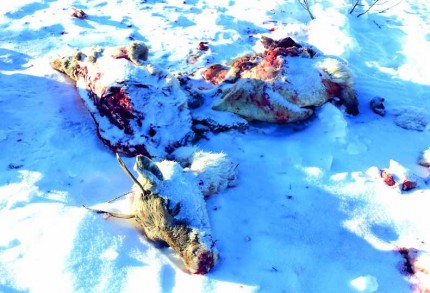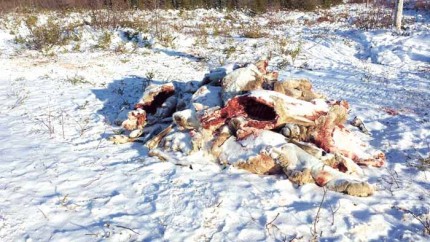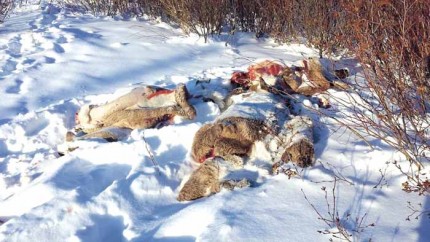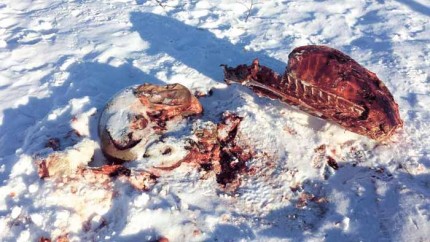
“Oh my gosh, it was a complete disgrace,” said Nadia Saganash, describing her initial reaction to photos of caribou carcasses left to rot along the highway near Chisasibi. “It’s hard to look at, especially for Elders and community members; these are edible and consumable parts.”
Saganash is the Wildlife Management Administrator of the Cree Nation Government (CNG). Unfortunately, she says, the carelessness shown by sport hunters in Zone 22-A of northern Quebec isn’t new, just more evidence of an ongoing problem.
The carcasses were discovered earlier this month when Chisasibi resident Roger Orr was heading out to hunt, coming across the remains of about 10 caribou near the Sashaw Sibi access road. Heads, spines, legs and other less desirable pieces littered the roadside and a nearby parking lot. Only the prime meat had been stripped from the animals.
As caribou herds decline across Quebec, pictures of the wasted carcasses that Orr posted on Facebook sparked outrage across Eeyou Istchee.
It isn’t entirely clear who is responsible for the mess, but both Orr and Saganash have their suspicions. Saganash noted that while the CNG isn’t sure whether the culprits are poachers or sport hunters, they suspect the waste may have come from Ontarians who legally cannot import certain animal parts into their home province.
“It’s unacceptable and it won’t be tolerated,” said Saganash. “We’ve brought this issue up to the Hunting Fishing and Trapping Coordinating Committee (HFTCC) and the Quebec government and we’re taking actions with the outfitters to see that they implement some measures to ensure this doesn’t happen again.”
Orr’s assessment of the waste was clear. “It was all hunters from the south who were parked there,” said Orr. “They were all parked near the hydro line, there were a lot of skidoo tracks and the caribou remains were piled in plain sight.”
While Orr admitted that it’s difficult to always use every last bit of animal remains, he says that Cree hunters have a different approach to hunting.
“It’s not Cree,” he said. “There’s a big difference in the style of it. It’s definitely not cultural practice to do that kind of butchering. Our way is sustainable. We replenish the resources so future generations can survive. If one understands the spirt of in’do’houin, it’s not about pulling the trigger, it’s about why you pull the trigger, why you’re killing the animal.”
There is a spiritual aspect to every kill, Orr continued. “It allows you to harvest a bounty so that you can continue to feed your family, your children, your people. By showing respect it always ensures your safety. Once you start taking for no meaning other than entertainment, that spirit is aware of that and makes it harder for one to harvest.”

Saganash noted that Area 22-B has become a hot spot for hunters. As the nearby herd migrates closer to the community the outfitting companies in the area are sending more clients to this zone.
“Not all of the sport hunters are guided,” she said, “but most of these outfitters have been sending hunters into a small portion of that territory. That’s where the sport hunters are concentrated because that’s where the caribou are. There have been ongoing security issues and the hunters there have left their mark.”
Saganash says the Cree Nation Government is in contact with wildlife protection, the fishing and trapping association and the local outfitting companies, and has asked the outfitters to clean up the site. She says that the two sites were cleaned up but that more work needs to be done to prevent this type of behaviour.
“We want to make sure these incidents don’t occur again over this [hunting] season and that more regulations and stricter measures are put in place for next season,” she said. “It’s hard to change the regulations right now so we’re seeking collaboration from the outfitters to make sure they don’t send all of their clients to the same area. We’re proposing that the sport hunters bring back the whole caribou and that the outfitters manage the quartering and carving of the carcasses themselves.”
Other potential solutions include a hunting corridor along the Chisasibi road, reducing the amount of hunting permits given out each year, unifying zones 22-A and 22-B to distribute hunters more evenly and potentially even closing the hunting area entirely.
However, Saganash said there are simply not enough game wardens to cover such a large area.
“There’s a lot of awareness that needs to be created by the wildlife protection officers and the outfitters themselves, evidently there hasn’t been enough. We’ve been struggling with wildlife protection in the territory because they’re under-resourced. We have such a big territory and anything can happen.”
In response to the concerns of the CNG, Saganash says that Quebec’s Wildlife Protection Office has committed to have six officers permanently patrolling the area around Chisasibi for the remainder of the sport-hunting season. The CNG also set up a conference call with the four outfitting companies in the area to discuss measures to be taken immediately to avoid similar incidents.
“The caribou can’t speak for themselves,” declared Orr. “Somebody has to speak for them. All it takes is a few pictures posted and you create that awareness that pushes the representatives and the people in charge to see what they can do.”


Response of Grand Chief Matthew Coon Come
“The Cree Nation Government/Grand Council of the Crees was well informed of the wastage and security incidents occurring along the Chisasibi road at the opening of the sport-hunting season. This is a situation that has been reoccurring for far too long. Year after year, since the opening of the winter sports hunt, we have brought this issue to the attention of the Quebec government, and yet very little actions or measures have been taken to respond to the matter.
It is a complete disgrace to see body parts and whole carcasses left on the land to waste. This will no longer be tolerated. Wastage of any animal or animal parts is contradictory to the customs and values of Cree traditions. Certain animal parts, such as the head and limbs, are constantly discarded by sports hunters, but these are consumable and usable parts for the Crees. For our members, especially our Elders, to witness such waste is very disturbing and disrespectful to both the animal and our customs. As tradition dictates, a hunter (whether Cree or non-Cree) must not waste any parts of the animal. This is what our Nation must stand by. Anyone coming into the territory is expected to respect the land and its people.
We have been in contact with the Quebec Wildlife Protection Office and the Hunting, Fishing and Trapping Coordination Committee (HFTCC) to report the incidents and are taking necessary measures to prevent any future occurrences. The Wildlife Protection Office has reassured us that there will be adequate resources patrolling the area throughout the sport hunt season. We have also been in contact with the outfitter to address the matter. It was brought to our attention that the outfitters immediately cleaned up the site. We would like to express our appreciation towards their immediate response. However, the issues are not completely resolved and we fear these incidents may occur again. We are seeking further collaboration from outfitters, the Quebec Wildlife Protection Office and HFTCC to implement interim measures to help prevent these unacceptable incidents. These measures are presently in discussion.
We urge the Quebec government to act diligently on this matter. The conduct of some sport hunters is unacceptable and the inability of Quebec government to properly manage this hunt over the years forces us to call for the complete closure of the winter sports hunt in 2017-18. This is imperative given the recorded continued decline of the Leaf River Herd. To prevent the same fate as the George River Herd where a drastic population decline is threatening their existence, measures will be required to alleviate pressures on the Leaf River Herd. This request is in respect to the Priority of Native Hunting as provided for in Section 24.6 of the JBNQA.”

